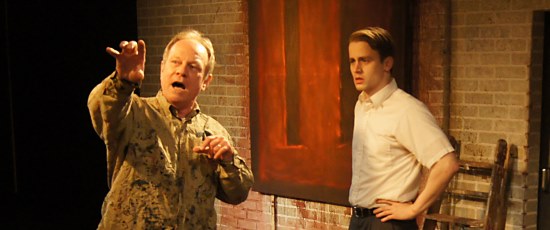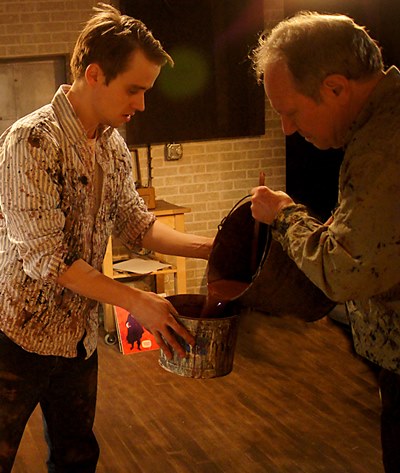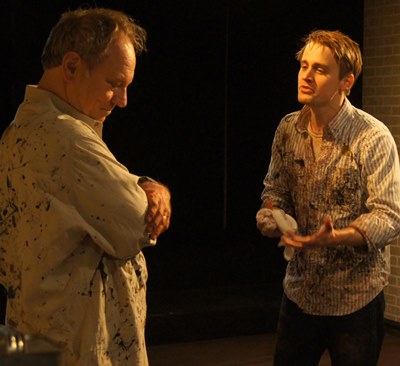‘Red’ at Redtwist Theatre: As leonine Rothko roars, younger artist sees a changing canvas
 Review: “Red” by John Logan, at Redtwist Theatre, extended through March 29. ★★★★
Review: “Red” by John Logan, at Redtwist Theatre, extended through March 29. ★★★★
By Lawrence B. Johnson
There’s nothing simple about either life or the color red. Both exist only as seemingly infinite inflections of their root ideas. But black is another matter. If red bespeaks life in all its surging complexity, black is its absolute opposite, the absolute end. Or so declares the abstract expressionist painter Mark Rothko in John Logan’s play “Red,” which roils and rages with irrepressible force at Redtwist Theatre.
 Logan’s provocative two-hander springs from an actual incident in Rothko’s life (he died in 1970 at age 66), when he was commissioned to create a series of paintings to adorn a restaurant in the new Four Seasons hotel in New York City. He envisions a sort of communion circle of thought-provoking images surrounding diners who, viewing his art, would be transported to a place deeper within themselves than their empty stomachs.
Logan’s provocative two-hander springs from an actual incident in Rothko’s life (he died in 1970 at age 66), when he was commissioned to create a series of paintings to adorn a restaurant in the new Four Seasons hotel in New York City. He envisions a sort of communion circle of thought-provoking images surrounding diners who, viewing his art, would be transported to a place deeper within themselves than their empty stomachs.
In any case, that’s the blue-sky project at hand in Rothko’s studio when in walks Ken, the celebrated painter’s new assistant. Rothko’s first commands to the young man are to get rid of the jacket and tie (paint is splashed here) and to describe what he sees in the unfinished painting before him – a great wash of red bisected horizontally by a linear rectangle in black.
It’s a sort of aptitude test, for which the correct answer is not the fundamental color red. What does red signify, anyway? It might be carmine or crimson or brick or rust or any of a hundred other expressions. But it is all life-informing, and it is all good. Anyway, all is good for Rothko within the walls of this, his bastion of creativity, his insulated world and private domain. But like moisture through cracks, the reality of the outside world eventually seeps in – channeled in part by youthful Ken, who comes gradually to perceive the great artist as the vain and conflicted mortal that he is.
 Brian Parry cuts a prepossessing figure as Rothko – brilliant, petulant, self-centered, albeit quite naïve where the world beyond his studio is concerned. In Aaron Kirby’s progressively awakening acolyte Ken, this flinty Rothko enjoys a splendid foil. The hand of director Steve Scott is virtually before us as master and youth circle, conjoin, clash, reveal their foibles and trumpet their passion for art.
Brian Parry cuts a prepossessing figure as Rothko – brilliant, petulant, self-centered, albeit quite naïve where the world beyond his studio is concerned. In Aaron Kirby’s progressively awakening acolyte Ken, this flinty Rothko enjoys a splendid foil. The hand of director Steve Scott is virtually before us as master and youth circle, conjoin, clash, reveal their foibles and trumpet their passion for art.
Ken, it should be mentioned, is also an artist, a vital matter the young man can never quite bring himself to share with the monumentally egocentric Rothko. Ken learns the hard way about eliciting compassion from an insulated genius, which may be a redundancy in any case. When the kid tells the great man about a horrible event from his childhood, Rothko’s initial expression of sympathy eventually turns sour and dismissive. That paint-spattered clothing might be Rothko’s skin; he is what he is, and surrogate father is not on his palette.
The play is replete with dazzling monologues, notably from Rothko on the meaning and value of art, especially his own. And yet just as vehemently, he ridicules the rich people who buy his work, damning them for turning him into a noun, as in owning a Rothko. Parry delivers these fiery harangues with the single-minded intensity of a preacher admonishing his flock.
 Yet degree by clear-eyed degree, Kirby’s observant and increasingly bold Ken emerges from Rothko’s broad shadow to confront the painter with his human frailty, his hypocrisy and the shelf-life of his ascendancy. The scene of that throw-down, the confident youth on the attack and the old demi-god backed into a corner, silent, surely will endure in memory. As will Ken’s meek acknowledgement that he’s doubtless just got himself fired – and the stunned master’s off-hand riposte.
Yet degree by clear-eyed degree, Kirby’s observant and increasingly bold Ken emerges from Rothko’s broad shadow to confront the painter with his human frailty, his hypocrisy and the shelf-life of his ascendancy. The scene of that throw-down, the confident youth on the attack and the old demi-god backed into a corner, silent, surely will endure in memory. As will Ken’s meek acknowledgement that he’s doubtless just got himself fired – and the stunned master’s off-hand riposte.
This is the third production I’ve seen of “Red,” and certainly the most intimate. Patrons seated in the front row of Redtwist’s tiny performing space are provided with coverings against the spray of paint. I loved the fly-on-the-wall perspective on a character whose monumental vision, and ego, Parry conveys with unbending conviction. And yet, that said, Kirby is no less persuasive as the personification of art’s next wave, which must come, as revitalizing as it is inexorable.
Related Links:
- Performance location, dates and times: Details at TheatreinChicago.com
- Preview of Redtwist Theatre’s complete 2014-15 season: Read it at ChicagoOntheAisle.com
-
Broadway’s “Red” swept the Tonys in 2010: Go to Internet Broadway Database
-
A previous Chicago take on “Red”:Go to ChicagoOntheAisle.com
Tags: Aaron Kirby, Brian Parry, John Logan, Mark Rothko, Red, Redtwist Theatre, Steve Scott

